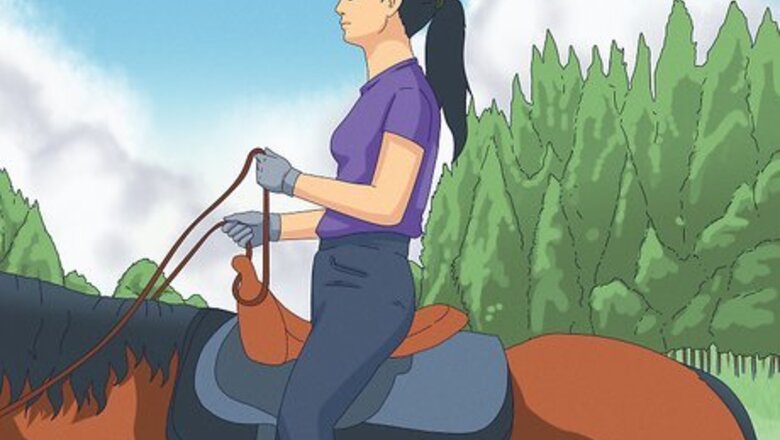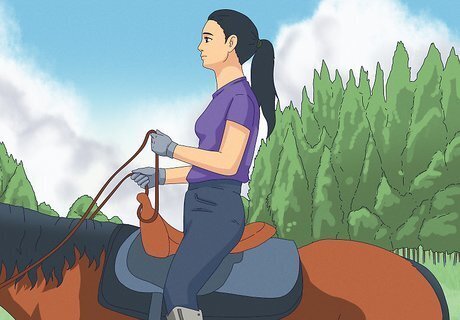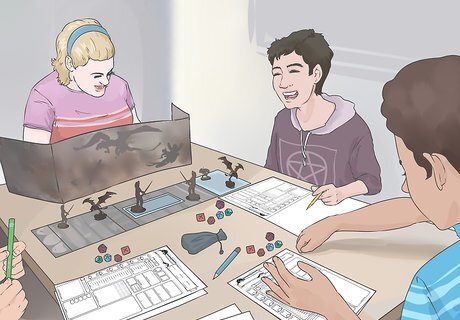
views
What is mounted combat in D&D 5e?

Mounted combat is a mechanic allowing you to ride a mount in-game. “Mounted combat” simply means your PC (player character) rides a creature during battle. In D&D 5e, mounts are defined as a willing creature at least 1 size larger than the rider with the appropriate anatomy. They can greatly increase a PC’s mobility on the battlefield. A “willing creature” is essentially one that has either been bred or trained to be ridden (like a horse) or is intelligent enough to consciously consent to being ridden (like a pegasus). In D&D 5e, size categories include tiny, small, medium, large, huge, and gargantuan. So, if your PC is a medium-sized creature, they’d need a large-sized mount (or bigger). “Appropriate anatomy” means a creature with the body shape and structure to support a rider. The DM can ultimately decide this, since the base rule is vague enough to allow interpretation.
How to Mount and Dismount
It costs half of your PC’s movement to mount or dismount. When your PC has a mount, you can spend half your PC’s movement speed to mount or dismount. You can only do this once per turn—and only if your PC has at least half their normal movement speed remaining. Additionally, your PC must be within 5 feet of the mount, regardless of size or reach. Mounting and dismounting always cost half your PC’s movement speed, no matter what it is. For example, if your PC has a 30-foot movement speed, it costs half of that (15 feet) to mount or dismount. Similarly, if your PC has a 50-foot movement speed, it costs 25 feet to mount or dismount. Your PC also can’t mount or dismount if their speed is currently 0 (due to a condition or spell currently affecting them, for example).
Enemy attacks or other effects may force your PC to dismount. If an effect moves your mount against its will (or yours), your PC must make a DC 10 Dexterity saving throw. If they succeed, they remain mounted; otherwise, they’re thrown off the mount and land prone within 5 feet of the creature. This saving throw also applies if your PC is knocked prone while mounted. If a mount is knocked prone, you can use your PC’s reaction to dismount and land on your feet; if you don’t (or can’t), your PC will fall prone as well within 5 feet of their mount. Effects that can move your mount include spells like Thunderwave or Earthquake, attacks like a Grapple or Shove, or even a terrain effect like a rockslide. If your PC or mount falls prone (meaning they’re knocked off their feet and fall to the ground), it costs half their movement speed to get back up. Additionally, if your mount is knocked prone while flying (since some mounts are capable of flight), that means both the mount and your PC would fall out of the air.
Controlling Mounts
You can control mounts that have been trained to allow riders. In other words, any old animal can’t serve as a controlled mount; it has to be a domesticated creature (like a horse, donkey, or griffon) capable of taking commands from your PC. A controlled mount’s initiative matches your PC’s; it can move and act on the turn you mount it, and it moves as directed, with 3 available actions: Dash, Disengage, and Dodge. Dash. The Dash action essentially doubles a creature’s movement speed for that turn, allowing it to move in place of taking any other action. A mount’s ability to move fast and dash is what increases your PC’s mobility! Disengage. Taking the Disengage action means your mount won’t provoke opportunity attacks from enemies (unless an enemy has the Sentinel feat). Dodge. Taking the Dodge action means enemy attacks against your mount have disadvantage, and the mount has advantage on saving throws (making it harder to hit).
Or, you can let intelligent mounts act independently instead. Additionally, intelligent mounts are always independent, meaning they act of their own will instead of taking commands from your PC. Independent mounts keep their own place in initiative order, and having a rider doesn’t restrict the actions the mount can take. They can attack, run away, and even act against your PC’s wishes. Generally, any creature with an Intelligence score of 5 or higher is considered “intelligent.” So, if an intelligent creature allows your PC to ride them, the creature would count as an independent mount. For example, a dragon or pegasus could both be considered independent mounts (since both have an Intelligence score over 5). You could potentially ask your DM to implement a house rule allowing your PC’s initiative to line up with their independent mount. Otherwise, you could try taking out enemies with initiative scores between your PC and their mount so their turns are closer together.
How does mounted combat work?
The DM decides where riders on large mounts are placed. The official 5th addition rules don’t specify where riders are placed on mounts—so, as is the case for most details that aren’t explicitly stated, the DM can make the final call. There are typically two options: either a PC can occupy the entire space their mount occupies, or they have a specific space within the mount’s occupied squares. For example, a large-sized mount takes up 10 x 10 feet of space, while a medium-sized rider occupies a 5 x 5-foot square. So, a DM could rule that the medium-sized rider can reach all enemies within a 10 x 10-foot space (since that’s the size of their mount). Alternatively, a DM might rule that a medium-sized rider occupies a particular square within the mount’s space and can only reach enemies within 5 feet of them. This distinction matters because it determines when enemies can target a PC (or their mount) and when PCs can make melee attacks in combat.
Spells cast on your PC don’t affect the mount unless specifically stated. Since many spells in 5e can target a single creature, enemies must choose to target either your PC or their mount. The only spells that automatically affect both your PC and their mount are area-of-effect spells since they explicitly affect all creatures within the spell’s radius. For example, a Fireball spell is area-of-effect, so it affects your PC, your mount, and any other creatures within its 20-foot radius. However, if an enemy casts Ice Knife at your PC, only they would take the damage and not their mount (since Ice Knife targets a single creature).
Enemies can make attacks of opportunity against your PC or mount. Attacks of opportunity trigger when one creature moves outside of another’s melee range—and, unfortunately, they can spell trouble for you and your mount. If your mount provokes an opportunity attack by moving away from an attacker, they can choose to target either your mount or your PC. This can be deadly for a mount with low hit points (HP) because an enemy might decide to attack the mount instead of its rider. Similarly, a PC trying to avoid drawing enemy fire might still get hit instead of their mount if they trigger an opportunity attack. Keep in mind that having your mount use the Disengage action (if possible) can prevent opportunity attacks.
Your PC can wield a lance with one hand while mounted. The one 5e weapon with special attributes in mounted combat is the lance; while it’s ordinarily a two-handed weapon, a PC riding a mount can wield a lance with one hand. Attacks made with lances also have disadvantage against targets within 5 feet. Disadvantage means your PC would have to roll their d20 twice and take the lower result for an attack roll against a creature within 5 feet. However, this isn’t necessarily an issue during mounted combat; for example, PCs riding horses can simply Disengage and move away to use their lance (or switch weapons when necessary). Similarly, PCs riding bigger mounts (like elephants) might actually need a lance since the extra reach is critical to helping them land hits on enemies.
What is the Mounted Combatant feat?

The Mounted Combatant feat offers additional perks for mounted combat. Found in the Player’s Handbook, Mounted Combatant is an optional feat that you can give your PC if you want them to excel in mounted combat. With the Mounted Combatant feat, your PC will gain the following benefits while mounted (and not incapacitated): They’ll get advantage on melee attacks against unmounted creatures that are smaller than their mount. Your PC can force attacks on a mount to target them instead. When your mount is exposed to an effect that forces it to make a Dexterity saving throw to take half damage, it’ll take no damage at all if it succeeds the save (or half damage if it fails). If you give your PC Mounted Combatant, consider giving them the Defensive Duelist feat too; it lets you add your PC’s proficiency bonus to their armor class when targeted by a melee attack, which can save the day when your PC intercepts attacks meant for their mount.
Magic Items that Affect Mounted Combat
Certain items can give your PC unique, magical mounts. Throughout your PC’s travels, they might find magical items that can either give them a new mount or benefit their current mount! Keep an eye out for the following items (or ask the DM if you can purchase them from a magic shop in-game): Horseshoes of a Zephyr. These can be affixed to a horse (or similar creature), allowing the creature to move normally while floating 4 inches above the ground, plus travel at normal speed up to 12 hours each day without suffering exhaustion. Horseshoes of Speed. When affixed to a horse (or similar creature), these horseshoes increase the creature’s walking speed by 30 feet. Saddle of the Cavalier. Your PC can’t be dismounted against their will while conscious with this saddle equipped on a mount. Additionally, attack rolls against the mount have disadvantage. Figurines of Wondrous Power. There are several varieties of figurines, each with the power to temporarily transform into a living creature when a command word is spoken. This includes: Bronze griffon (rare). This transforms into a live griffon—a durable creature with a decent flying speed your PC can ride as a mount. Ebony fly (rare). This figurine can transform into a giant fly that can be ridden as amount. It also has darkvision. Ivory goats (rare). This figurine has 3 versions: the Goat of Traveling (which has the statistics of a warhorse), the Goat of Travail (which turns into a giant goat), and the Goat of Terror (which comes with a fear aura and horns that can become weapons). Marble elephants (rare). This figurine can become a live elephant for up to 24 hours at a time. Obsidian steed (very rare). This can turn into a nightmare, which is a type of horse-like steed; it’ll defend itself in battle, though there’s a chance it’ll ignore the orders of a good-aligned rider. Onyx dog (rare). This figurine becomes a mastiff, which is a medium-sized creature (so only small-sized PCs can use it for a mount). Serpentine owl (rare). This becomes a giant owl—another handy mount with a fly speed. It can also communicate telepathically. Gold canary (legendary). This figurine becomes a giant canary that can be used as a mount (similar to the griffon or owl).
Mount Options to Use in Combat
Standard Mounts Although there’s technically no limit to the different animals your PC might be able to domesticate and use as a mount, several more “typical” D&D steeds fall into the category of a standard mount. Depending on where your PC is and how much money you have, these animals shouldn’t be too difficult to acquire. This includes: Camels (50 gold). They have a walking speed of 50 feet and a carrying capacity of 480 lb. Donkey (8 gold). They have a walking speed of 40 feet and a carrying capacity of 420 lb. Elephant (200 gold). They have a walking speed of 40 feet and a carrying capacity of 1,320 lb. Draft horse (50 gold). They have a walking speed of 40 feet and a carrying capacity of 540 lb. Riding horse (75 gold). They have a walking speed of 60 feet and a carrying capacity of 480 lb. Mastiff (25 gold). They have a walking speed of 40 feet and a carrying capacity of 195 lb. Pony (30 gold). They have a walking speed of 40 feet and a carrying capacity of 225 lb. Warhorse (400 gold). They have a walking speed of 60 feet and a carrying capacity of 540 lb.
Beast Master Ranger Mounts PCs with the Beast Master ranger subclass have the ability to summon a beast companion—and, if you like, you can choose a companion that can also serve as a mount. However, keep in mind that unless you choose one of the standard options above, all of the following are medium-sized (meaning only a small-sized PC can use them as mounts): Dimetrodon. They have a walking speed of 30 feet. Giant Badger. They have a walking speed of 30 feet and a burrow speed of 10 feet. Giant Crab. With a swimming speed of 30 feet, it’s most useful on an underwater adventure. Giant Frog. They have a walking speed of 30 feet a standing leap ability (so they can jump up to 20 feet long and 10 feet high). Giant Weasel. They have darkvision, keen hearing and smell, and a walking speed of 40 feet. Giant Wolf Spider. They have blindsight, darkvision, spider climb, and a walking (and climbing) speed of 40 feet. Hyena. They have Perception, pack tactics, and a walking speed of 50 feet. Panther. They have a keen smell, proficiency in Stealth and Perception, a walking speed of 50 feet, and a climbing speed of 40 feet. Pteranodon. They have a flying speed of 60 feet and a walking speed of 10 feet. Wolf. They have proficiency in Stealth and a walking speed of 40 feet.
Find Steed & Find Greater Steed Mounts Find Steed is a 2nd-level paladin spell allowing the caster to summon an intelligent and loyal steed that serves as a mount both in and out of combat. Find Greater Steed is a 4th-level paladin spell with the same basic function; it simply summons more powerful mounts. Regardless, any steed created by either spell is a celestial, fey, or fiend (your choice). Find Steed allows you to summon a warhorse, pony, camel, elf, mastiff, or another animal approved by the DM (which you can suggest). Find Greater Steed allows you to summon a griffon, pegasus, peryton, dire wolf, rhinoceros, or saber-toothed tiger Keep in mind that while you can control the steed in combat, every option will have a base Intelligence score of at least 6.
How to Fight Mounted Enemies
Target enemies’ mounts to limit their mobility. Since enemies with the ability to zip around a battlefield on a mount can be troublesome, the most effective solution is to eliminate the mount. Since an enemy with the Mounted Combatant feat can redirect your attacks, however, try targeting both the enemy and mount with area-of-effect damage. For example, a single Fireball spell deals 8d6 fire damage to all creatures in a 20-foot radius, dealing an average of 28 damage per spell. Comparatively, warhorses have 19 hit points. So, if an enemy were riding around on a warhorse, it’d likely only take a single spell to eliminate the mount.
Knock enemies off their mounts to separate them. Even if eliminating a mount isn’t as easy as you thought it would be, you can still put enemies at a disadvantage by distancing them from their mount using spell effects like Thunderwave, Grasping Vine, Lightning Lure, or Gust of Wind. Essentially, try to put at least 5 feet of space between the mount and rider and knock the rider prone. This is a handy tactic because if the rider is knocked prone, they’ll have to use half their movement to stand up. Remounting also requires half the rider’s movement, so if they’re forced more than 5 feet away, they wouldn’t have enough movement to stand up and remount in a single turn. In that case, an enemy rider might have to Dash in order to stand up and re-mount, which means they wouldn’t be able to use their action to make any attacks that round.
Should you use a mount?

Consider using a mount if you want the extra movement speed. Ultimately, mounts don’t add a ton of firepower in battle. The main reason to use one is the bonus movement speed (or flying speed, depending on the mount) since you can rely on a mount to transport your PC quickly around a battlefield. So, mounts could be worth using if mobility is an issue—but there are other ways to speed up your PC as well. For example, you could give your PC the Mobile feat for extra movement speed or track down Boots of Speed (which doubles a PC’s walking speed). Ultimately, you have options when it comes to increasing your PC’s movement speed—but if you feel a mount could add some fun and extra flavor to your PC’s combat style, go ahead and use one!




















Comments
0 comment